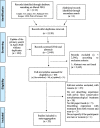Conservative non-pharmacological interventions in women with pelvic floor dysfunction: a systematic review of qualitative studies
- PMID: 36503437
- PMCID: PMC9743653
- DOI: 10.1186/s12905-022-02097-y
Conservative non-pharmacological interventions in women with pelvic floor dysfunction: a systematic review of qualitative studies
Abstract
Background: Women's adherence is essential to physiotherapeutic treatment of pelvic floor dysfunction, but its related factors are not usually considered in the development of treatment approaches. This study aims to understand how women with pelvic floor dysfunction experience pelvic floor conservative non-pharmacological treatment options.
Methods: A systematic review of qualitative studies. The electronic search was performed in MEDLINE/PubMed, CINAHL, Lilacs, SCOPUS, and Web of Science databases. Primary articles on qualitative methods focused on the experience of women regarding pelvic floor conservative non-pharmacological interventions, i.e., pelvic floor muscle training (PFMT), either associated or not with biofeedback, perineal massage, vaginal dilators, and others. A meta-aggregation was performed.
Results: It was included 22 manuscripts in this review. It was found seven studies about the use of vaginal devices, two about manual intervention and 14 studies on women's experience with PFMT. The findings were synthesized as follows: I) women's experience of manual interventions; II) women's experience using vaginal devices changes according to health professional attitudes; III) women's experiences using vaginal devices varied depending on their pelvic floor dysfunction; IV) reported side effects due to the use of vaginal devices; V) external factors influencing PFMT performance; VI) women's perception of their own personal factors influencing PFMT performance; VII) PFMT characteristics influencing women's adherence; VIII) strategies used by women to include PFMT in their routine.
Conclusion: Women's experience with pelvic floor conservative non-pharmacological treatment options is a complex phenomenon that involves many more variables than simply personal aspects. This is a systematic review of qualitative studies registered in the PROSPERO (CRD42018080244).
Keywords: Pelvic floor; Physiotherapy; Women’s experience; Women’s health.
© 2022. The Author(s).
Conflict of interest statement
The authors declare that they have no competing interests.
References
Publication types
MeSH terms
Grants and funding
LinkOut - more resources
Full Text Sources


